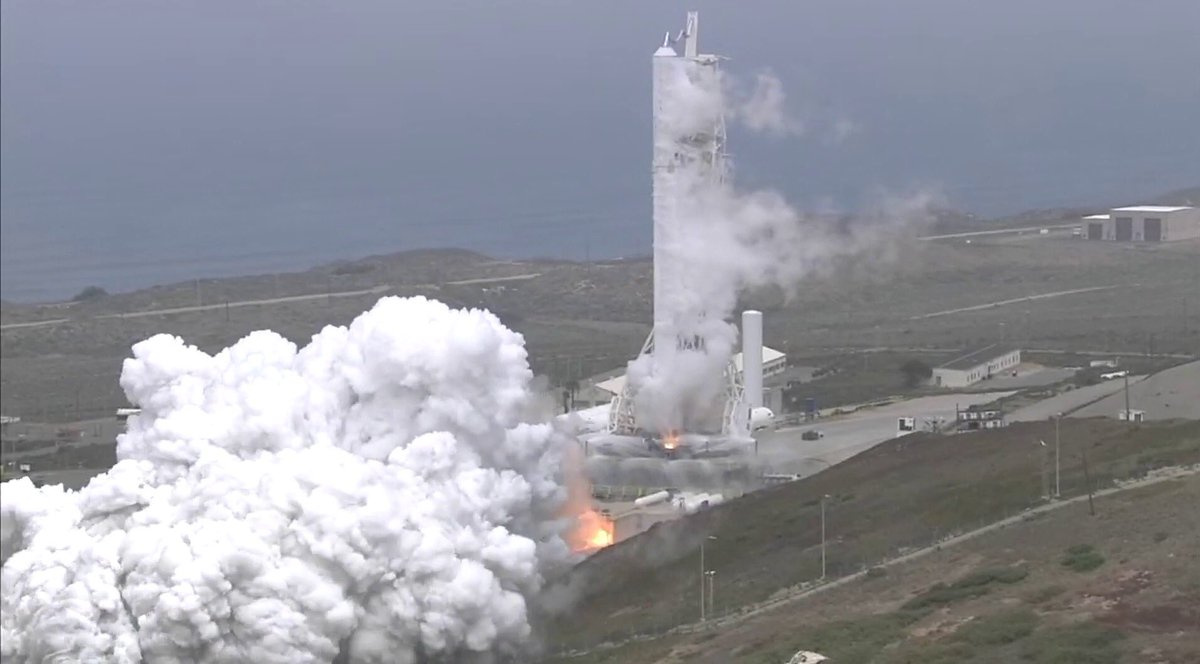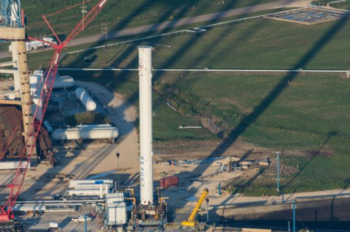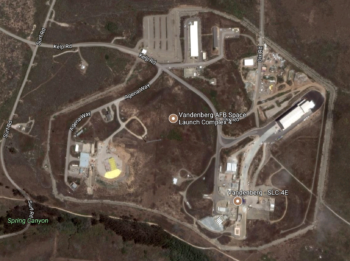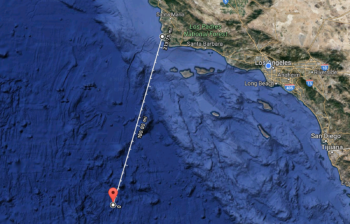SpaceX tested Formosat-5 Falcon 9, with plans for another landing on an autonomous platform

Preparing for the second launch this year from Vandenberg, SpaceX conducted static fire tests of the Falcon 9 rocket. It will put the extremely light Taiwanese satellite Formosat-5 into orbit on Thursday, August 24, at 18:50 GMT from the SLC-4E launch pad at the Air Force base Vandenberg, California, with the landing of the first stage on the autonomous offshore platform "Just read the instructions."
Static fire tests and a redesigned launch schedule for the Western Missile Range
SpaceX held the last but one critical step for Falcon 9 before its launch five days later, on Thursday.

"Static fire tests" for Falcon 9 means that the first and second stages carry out a countdown of the launch , together with refueling with rocket fuel - kerosene and liquid oxygen, and usually ends with the launch of all nine Merlin-1D engines of the first stage on the launch pad for a time of ~ 3.5 seconds
In particular, this first stage, Core 1038, was manufactured in Hawthorne (California), guarded to the east by road, to MacGregor (Texas), where it was installed on the S1 test stand and passed a series of checks, including starting the engines for a time equal to full time future flight.
The exact time of such events is never known in advance, however, NASASpaceflight.com aerial photographs, available for viewing after registering on the forum , confirm the presence of Core 1038 on stand S1 on June 20, 2017, about a month before the scheduled launch of Formosat-5.

After a successful fire test in Texas, the Core 1038 was wrapped in transport protection and sent back west to Vandenberg Air Force Base, where she underwent final pre-launch preparation and second-stage assembly, which also passed fire tests at McGregor.
Since SpaceX announced that it was postponing the launch of Formosat-5 for a month - setting a new launch date on August 24, which would be after the planned launch of NROL-42 on the Atlas V rocket from the United Launch Alliance (ULA) , the launch schedule from Vandenberg began to change.
Further, during the preparation for the launch of the TDRS-M communications satellite, NASA faced problems that led to a 15-day shift in plans. And, although the satellite successfully launched on Friday (August 18) in the morning from Canaveral, Florida, the entire ULA launch schedule was forced to shift to the right in view of this delay.
The launch shift of TDRS-M made it necessary to postpone the launch of the NROL-42 for almost a whole month - from August 14 to September 11.
Because of this, Formosat-5 became the first in line for launch, after the July pause in the work of the Western Missile Range (which accompanies the Vandenberg cosmodrome) for its standard maintenance and equipment upgrades. A similar pause also occurred in July at the Eastern Missile Range (which works with the Kennedy cosmodrome).
Thus, SpaceX planned to conduct static fire tests of the Falcon 9 on Saturday, August 19, with a time window from 12:00 to 16:00 PDT. Confirmation that the tests took place immediately upon opening the test window was a sign of the absence of problems during preparation and countdown.
After completing the static fire tests, a quick review of the data was carried out to verify that everything is going according to plan, and that the launch team can continue to prepare for the launch scheduled on Thursday. SpaceX released a confirmation on its twitter shortly after the check.

This will be followed by a more detailed analysis of the data, ending with a Readiness Check for Start two days before launch. During this test, all elements of the launch campaign and static fire tests will be discussed again to officially allow the launch of Falcon 9.
If all goes well, SpaceX will launch Falcon 9 with Formosat-5 this Thursday, August 24th. Starting window from 18:50 to 19:34 GMT.
After Formosat-5, Westfield will switch to launching the ULA of the NROL-42 satellite on an Atlas V 541 rocket (five-meter payload fairing, four solid-fuel accelerators and a single-stage Centaur upper engine) on September 11, before moving back to SpaceX and launching Iridium Next 21-30, scheduled for September 30 at 13:30 GMT.
After Iridium Next 21-30, the lively manifesto of the launches of the Vandenberg cosmodrome for the rest of 2017 now looks like this:
| date | Rocket | Payload | Launch pad | Start time |
|---|---|---|---|---|
| October 12 | Delta II 7920 | JPSS 1 | SLC-2W | 09:48 GMT |
| 17 October | Minotaur-c | Skysat | SLC-576E | 21:37 GMT |
| end of the nobier | Falcon 9 | Iridium Next 31-40 | SLC-4E | in the plans |
| December | Falcon 9 | Iridium Next 41-50 | SLC-4E | in the plans |
| December 13th | Delta IV M + (5.2) | NROL-47 | SLC-6 | in the plans |
Formosat-5 - VKMS or not VKMS?
A feature of all launches from Vandenberg today was the inability to land from the VCMS (Return to Start) of the first stage of the Falcon 9 due to the high mass of the payload (for example: Iridium Next starts), because of which the residual fuel in the Falcon 9 tanks was not enough for landing, but also because official permits were not obtained and admission procedures were not completed by the United States Air Force ( USAF ), the Environmental Protection Agency ( EPA ), the Federal Aviation Administration ( FAA ) and the Department of Transportation ( DOT ).

However, on October 7, 2016, all the above-mentioned institutions completed an assessment of various environmental impacts for the construction and use of the landing site near the SLC-4W in order to allow the landing of the first-stage EFM Falcon 9.
"After analyzing and analyzing the available data and information on the existing conditions and potential impacts, including EA-2016 , the FAA decided to issue SpaceX licenses for reactive braking and landing of the Falcon 9 rocket on the SLC-4W platform ... will not have a significant impact on the quality of the human environment within the meaning of the National Environmental Policy Act . "
So says the report of the Federal Aviation Administration for Commercial Space Transport on the Approval of the Environmental Assessment and the Definition of Any Significant Impact of Deceleration and Landing of the First Step Falcon 9 at the SLC-4W Site at the Air Force Base Vandenberg, California, and Unforeseen Circumstances for Landing Open Sea.
The same report also concluded that there was no significant impact on terrestrial and marine life during landings from VKMS to Vandenberg.

After the official approval of the report in October 2016, SpaceX began construction of a landing pad on the SLC-4W, located just 430 meters from the launch table SLC-4E (the distance between the centers is indicated).
And now, a little more than 10 months after the permission to build the landing site on the SLC-4W and the ability to issue licenses for landing with VCMS for SpaceX launches from the west coast, here is finally the first mission with a light enough payload to perform with VMS .
The Taiwanese Formosat-5 satellite weighs only 475 kg and leaves more than enough fuel for the reverse, braking and landing maneuvers of the engines to safely return to the SLC-4W.
However, the launch and landing licenses requested from SpaceX and provided by the FAA for Formosat-5 provide for the landing of the first stage on the “Just read the instructions” autonomous offshore platform, which will be located about 344 km from Vandenberg.

The question arises why SpaceX will land on the platform instead of landing on land, because all the environmental barriers have been removed, and the Falcon 9 has the ability to land with VKMs.
One of the possible answers is that the landing site and the associated auxiliary facilities for landing the first stage were not completed by the time SpaceX had to apply for licenses to launch and land the Formosat-5 mission, i.e. . by June 28, 2017.
It is very possible that the landing site and the modernization of the facilities should have been completed by the time the license for landing was requested, since otherwise the FAA would have difficulty approving it without being able to examine the operational status of the entire landing complex.
It is possible that the landing site and related objects have not been completed even now.
Regardless of the current state of the SLC-4W landing pad, the first tier of the Falcon 9 will land on an autonomous offshore platform, so maybe it will be the ninth first tier saved this year.
(Photos: SpaceX, Chris Gebhardt and Philip Sloss twitter for NASASpaceflight.com, Google Maps and McGregor L2 via Gary Blair)
August 19, 2017 (c) Chris Gebhardt
UPD: Made several editorial changes to improve the quality of translation. Thanks knstqq !
All Articles